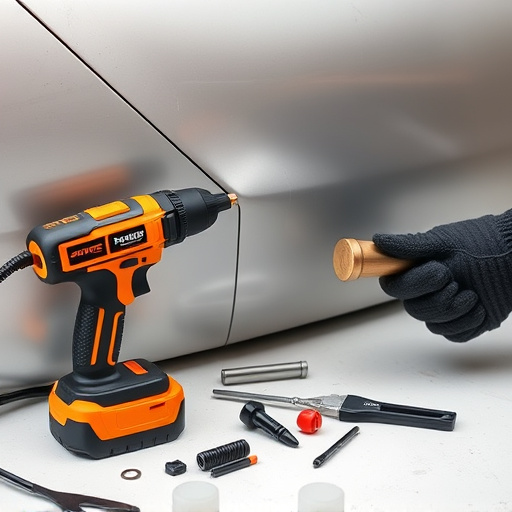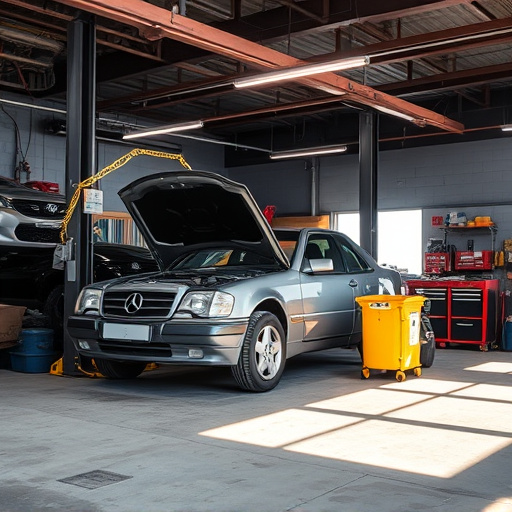Mastering Tesla Cybertruck Repairs: Tools, Maintenance, Calibration

Specialized tools are vital for accurate Tesla Cybertruck repairs, including diagnostic scanners, ha…….
In the rapidly evolving world of electric vehicle (EV) technology, the Tesla Cybertruck stands out as an iconic and controversial design, capturing global attention since its reveal in 2019. Along with its unique aesthetic, the Cybertruck brings a new dimension to EV repair and maintenance—a topic that is both technical and highly relevant in shaping the future of sustainable transportation. This article aims to delve into the intricacies of Tesla Cybertruck repair, exploring its various facets, from technological innovations to economic implications and global trends. By understanding the complexities of this process, we can better appreciate the challenges and opportunities it presents for the automotive industry.
Tesla Cybertruck repair encompasses a comprehensive set of tasks related to the maintenance, repair, and restoration of one of the most advanced electric pickup trucks on the market. This process involves several key components:
Structural Integrity: The Cybertruck’s iconic stainless steel body requires specialized techniques for welding, painting, and panel replacement, ensuring structural integrity while preserving its distinctive design.
Electrical Systems: As an all-electric vehicle (AEV), the Cybertruck’s repair involves intricate electrical work, including battery pack maintenance, motor repairs, and sophisticated computer systems calibration.
Automated Driving Features: Tesla’s Autopilot system is a defining feature of the Cybertruck. Repair technicians need to be adept at troubleshooting and calibrating sensors, cameras, and software to ensure safe and efficient autonomous driving.
Software Updates: Over-the-air (OTA) updates are a standard practice in modern EVs, including the Cybertruck. Repairs often involve flashing new firmware or software versions to address bugs, enhance performance, or add new features.
The repair process requires a unique blend of mechanical, electrical, and software skills, as well as a deep understanding of Tesla’s proprietary technologies. This has led to the development of specialized training programs and certification for technicians worldwide.
Tesla Cybertruck repair has left an indelible mark on the global automotive landscape, influencing several key trends:
Growing Demand for EV Skills: The increasing adoption of electric vehicles globally has created a surge in demand for skilled technicians capable of handling complex repairs like those required for the Cybertruck. This trend is driving investment in training programs and leading to the establishment of specialized repair centers worldwide.
Cross-Border Collaboration: Tesla’s global presence encourages cross-border collaboration between repair facilities, enabling knowledge sharing and ensuring consistent service quality across different regions. For instance, best practices from European repair shops can be adapted for the American market and vice versa.
Digitalization of Repair Processes: The Cybertruck’s advanced technology necessitates a digital approach to repair management. This includes the use of electronic work order systems, remote diagnostics tools, and online training platforms to streamline operations and improve efficiency.
Sustainable Practices: In line with Tesla’s commitment to sustainability, Cybertruck repairs emphasize eco-friendly methods. This includes the reuse of materials, recycling of parts, and the adoption of energy-efficient equipment in service centers.
The economic implications of Tesla Cybertruck repair are multifaceted:
Service Center Expansion: The increasing popularity of EVs, including the Cybertruck, has prompted Tesla to expand its network of official service centers worldwide. This trend is expected to continue as more regions embrace electric mobility.
Aftermarket Industry Growth: Independent repair shops and specialized aftermarket providers are adapting to cater to the unique needs of EV owners. While this competition challenges Tesla’s direct service model, it also fosters innovation and provides consumers with more choices.
Training Facilities: Private and public investments in training institutions focused on automotive technology are rising to meet the skilled labor demand. These facilities offer specialized courses tailored to EV repair, ensuring a pipeline of qualified technicians.
Research and Development (R&D): Tesla and its competitors are allocating substantial resources to R&D for EV repair technologies. This includes advancements in robotic systems, diagnostic tools, and efficient battery recycling methods, all of which shape the future of Cybertruck repairs.
The establishment of Tesla service centers has a ripple effect on local economies:
Job Creation: Service centers create high-skilled jobs, contributing to regional employment rates. Technicians, parts specialists, and administrative staff are among the roles added to support EV repair operations.
Supply Chain Expansion: The demand for specialized Cybertruck parts stimulates global supply chains, with manufacturers investing in production facilities to meet this niche market need.
Tourism Boost: In some cases, Tesla service hubs become tourist attractions due to their unique design and association with cutting-edge technology, drawing visitors to specific regions.
The field of Tesla Cybertruck repair is characterized by rapid technological advancements:
Robotic Welding and Assembly: Tesla has pioneered the use of robots for precise welding and assembly tasks, reducing repair times and ensuring consistent quality. This technology is also applied to structural repairs, enhancing efficiency.
Advanced Battery Technology: The development of more efficient and longer-lasting batteries, such as solid-state batteries, promises to simplify battery pack maintenance and replacement in the future, making Cybertruck repairs faster and less complex.
Autonomous Repair Robots: Research into autonomous repair robots is gaining momentum, with some companies aiming to automate various aspects of EV repair, from diagnostic checks to panel replacement. This could significantly reduce labor costs and increase service center capacity.
Digital Twin Technology: Using digital twins—virtual replicas of physical assets—repair technicians can access real-time data and predictive analytics for faster troubleshooting and more accurate repairs.
The legal framework surrounding Tesla Cybertruck repair is a critical aspect that varies across jurisdictions:
Safety Standards: All vehicles, including EVs, must comply with strict safety regulations. Repair facilities must adhere to these standards when replacing or retrofitting components, ensuring the vehicle’s structural and performance integrity.
Environmental Regulations: EV repairs are subject to environmental laws, particularly concerning the handling and disposal of hazardous materials like batteries. Strict guidelines ensure that repair shops manage e-waste responsibly.
Consumer Protection Laws: These laws protect EV owners from unfair practices and ensure transparent pricing for repair services. They also mandate the right to request a detailed estimate before undergoing any major repairs.
Data Privacy and Security: As Cybertruck repairs involve sophisticated computer systems, data privacy and security are paramount. Repair shops must handle vehicle diagnostics data securely and in compliance with relevant regulations like GDPR in Europe.
Despite its advancements, Tesla Cybertruck repair faces several challenges and criticisms:
Specialized Training Needs: The complexity of the Cybertruck’s systems requires specialized training for technicians, which can be a barrier to entry for independent shops and less experienced workers. Addressing this through comprehensive training programs is essential to ensure quality repairs.
Parts Availability and Lead Times: Given the unique design and customization options, finding replacement parts for rare or customized Cybertrucks can be challenging. Optimizing supply chain management and encouraging manufacturers to prioritize aftermarket support are potential solutions.
Cost of Repairs: EV repairs, including those for the Cybertruck, have been criticized as expensive due to the advanced technology involved. Transparent pricing structures and the adoption of digital tools for diagnostics can help reduce these costs over time.
Warranty and Service Policies: Tesla’s service policies, while comprehensive, have attracted criticism for being restrictive in certain cases. Balancing customer satisfaction with fair warranty claims is a delicate task that requires clear communication and flexible policies.
Germany has emerged as a hub for Tesla vehicle repairs, with several specialized centers adopting efficient practices. One such facility, located in Berlin, has achieved remarkable success by implementing robotic welding systems and digital work order management. They offer fast turnaround times and competitive pricing, attracting customers from across Europe. The key to their success lies in combining advanced technology with a customer-centric approach, ensuring a seamless repair experience.
In the United States, a community-driven initiative has connected local repair shops with EV owners, fostering a collaborative environment. This network leverages online platforms to share knowledge, resources, and best practices for Cybertruck repairs. The approach promotes affordability and accessibility, addressing common challenges related to specialized skills and parts availability. By harnessing the power of community, this network has successfully established itself as an alternative to official service centers.
Japan’s automotive industry is renowned for its precision and sustainability focus, and this is reflected in their approach to Tesla Cybertruck repair. A leading repair facility in Tokyo has implemented eco-friendly practices, including the use of recycled materials for parts and energy-efficient equipment. They also offer a comprehensive training program for technicians, ensuring a skilled workforce capable of handling complex repairs while minimizing environmental impact.
The future of Tesla Cybertruck repair is filled with promising trends and strategic considerations:
Digital Transformation: The digital revolution in the automotive industry will continue to shape repair processes. AI, machine learning, and IoT sensors will enable predictive maintenance, enhancing service quality and efficiency.
Decarbonization of Repair Processes: As sustainability becomes a priority, repair facilities will explore ways to reduce their carbon footprint. This includes electric vehicles for service center fleets, renewable energy sources, and efficient lighting systems.
Remote Diagnostics and Repair: The rise of 5G technology enables remote diagnostics and basic repairs, reducing the need for physical visits. This trend could simplify the owner experience while increasing service accessibility.
Collaboration Between Manufacturers and Independent Shops: Tesla and other EV manufacturers can foster partnerships with independent repair shops to improve parts availability and service coverage, especially in regions with limited official service centers.
Tesla Cybertruck repair represents a significant milestone in the evolution of automotive maintenance, reflecting the industry’s embrace of electric mobility and technological advancement. As the global adoption of EVs accelerates, the demand for skilled technicians and specialized services will continue to rise. This article has provided a comprehensive overview of the topic, highlighting its technical intricacies, economic implications, and the diverse landscape it creates.
The future holds immense potential for innovation in Cybertruck repair, with technological breakthroughs promising to revolutionize the entire process. As the industry navigates regulatory challenges, embraces sustainable practices, and explores new business models, Tesla Cybertruck repair will play a pivotal role in shaping the next generation of vehicle maintenance. By understanding and addressing the challenges presented, we can ensure that EV repairs contribute to a more efficient, accessible, and environmentally friendly transportation future.
Q: Are Tesla Cybertruck repairs more expensive than traditional car repairs?
A: While initial costs may be higher due to specialized parts and advanced technology, ongoing maintenance for EVs like the Cybertruck can be more cost-effective in the long run, thanks to reduced oil change intervals and simpler transmission systems.
Q: Can I get my Cybertruck repaired at any local garage?
A: Not all local garages are equipped to handle Tesla Cybertruck repairs. Specialized training and tools are often required, so it’s best to seek official service centers or certified repair facilities for guaranteed quality and safety.
Q: How do I know if a repair shop is qualified to work on my Cybertruck?
A: Look for certifications from Tesla or reputable industry bodies. Reputable shops should also be up-to-date with the latest software versions and have experienced technicians trained in advanced EV repair techniques.
Q: Are there any DIY kits available for basic Cybertruck repairs?
A: While some minor maintenance tasks can be performed by owners, most complex repairs, especially those involving electrical systems or Autopilot calibration, should be left to professionals due to potential safety risks and the need for specialized tools.
Q: How does Tesla ensure the availability of parts for rare Cybertruck customization options?
A: Tesla maintains a global inventory system and works closely with suppliers to prioritize aftermarket parts production for popular customization options. They also encourage customers to share their unique configurations to better meet demand.

Specialized tools are vital for accurate Tesla Cybertruck repairs, including diagnostic scanners, ha…….

Despite innovative design and electric power, Tesla Cybertrucks face common vehicle issues requiring…….

Tesla Cybertruck repair requires specialized tools for its unique assembly and aesthetic preservatio…….

Tesla Cybertruck repairs require specialized equipment and expertise due to its unique stainless ste…….

Tesla Cybertruck repairs pose unique challenges due to its distinctive angular design and advanced c…….

Tesla Cybertruck repairs require specialized care, with diagnostic scans followed by body shops for…….

Specialized skills and training are crucial for Tesla Cybertruck repair due to its unique design, ad…….